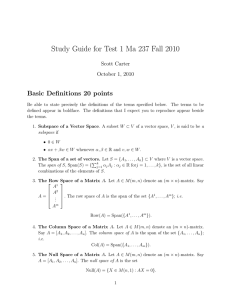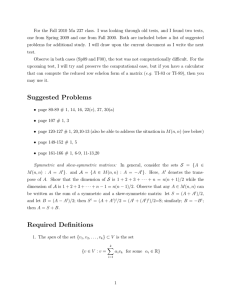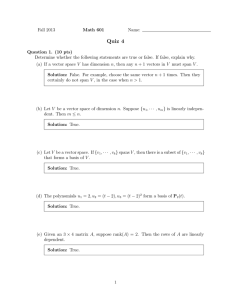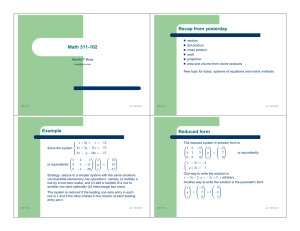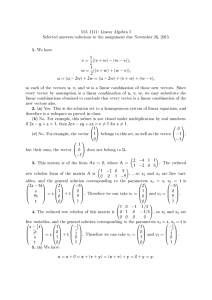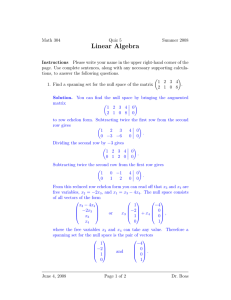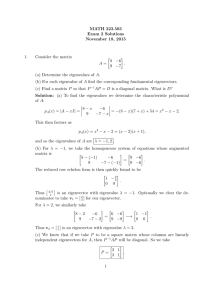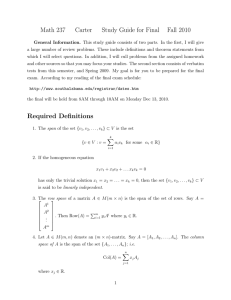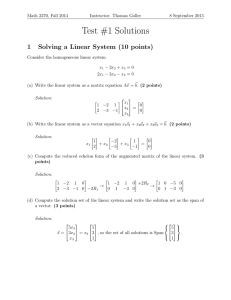Basic Definitions and Theorems Study Guide for Test 2 Summer 2013 Ma 237-101
advertisement
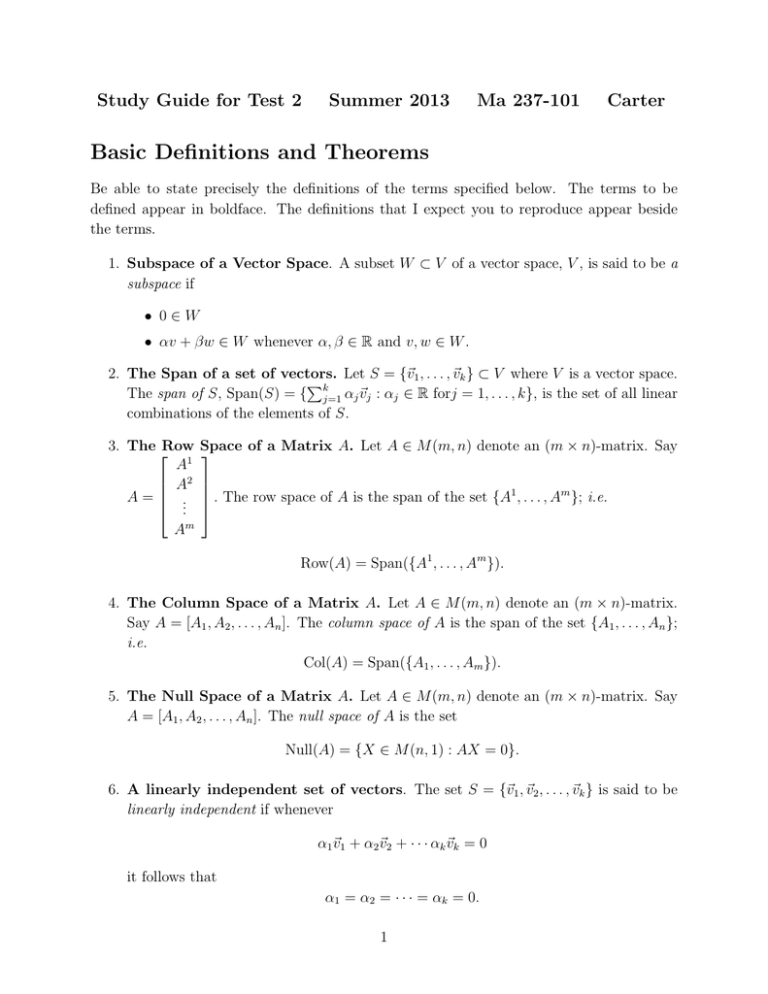
Study Guide for Test 2
Summer 2013
Ma 237-101
Carter
Basic Definitions and Theorems
Be able to state precisely the definitions of the terms specified below. The terms to be
defined appear in boldface. The definitions that I expect you to reproduce appear beside
the terms.
1. Subspace of a Vector Space. A subset W ⊂ V of a vector space, V , is said to be a
subspace if
• 0∈W
• αv + βw ∈ W whenever α, β ∈ R and v, w ∈ W .
2. The Span of a set of vectors. Let S = {~v1 , . . . , ~vk } ⊂ V where V is a vector space.
P
The span of S, Span(S) = { kj=1 αj ~vj : αj ∈ R forj = 1, . . . , k}, is the set of all linear
combinations of the elements of S.
3. The Row
A1
A2
A= .
..
Space
of a Matrix A. Let A ∈ M (m, n) denote an (m × n)-matrix. Say
. The row space of A is the span of the set {A1 , . . . , Am }; i.e.
Am
Row(A) = Span({A1 , . . . , Am }).
4. The Column Space of a Matrix A. Let A ∈ M (m, n) denote an (m × n)-matrix.
Say A = [A1 , A2 , . . . , An ]. The column space of A is the span of the set {A1 , . . . , An };
i.e.
Col(A) = Span({A1 , . . . , Am }).
5. The Null Space of a Matrix A. Let A ∈ M (m, n) denote an (m × n)-matrix. Say
A = [A1 , A2 , . . . , An ]. The null space of A is the set
Null(A) = {X ∈ M (n, 1) : AX = 0}.
6. A linearly independent set of vectors. The set S = {~v1 , ~v2 , . . . , ~vk } is said to be
linearly independent if whenever
α1~v1 + α2~v2 + · · · αk~vk = 0
it follows that
α1 = α2 = · · · = αk = 0.
1
7. A basis for a vector space. The set S = {~v1 , ~v2 , . . . , ~vk } is said to be a basis for a
vector space V , if
• S spans V , and
• S is a linearly independent set.
F
8. “rank/nullity theorem:” Let U ←− V denote a linear map from an n-dimensional
vector space V to an m-dimensional vector space U . Then
n = dim (Im(F )) + dim (ker(F )) = n = dim(V ).
Computational questions
1. Express the matrix
M=
4 7
7 9
as a linear combination of the matrices A, B, and C where
1 1
1 2
1 1
A=
, B=
, and C =
.
1 1
3 4
4 5
2. Let
A=
1
2
1
3
2
4
2
6
1 2 3 1
3 7 7 4
2 5 5 6
6 15 14 15
And let M4 denote the 4 × 4 matrix that
that a row echelon form of A is
1 2
0 0
A0 =
0 0
0 0
.
consists of the first 4 columns of A. Given
1
1
0
0
2
3
0
0
3
1
1
0
1
2
3
0
Find a basis for the column space of M4 and write the remaining columns of M4 as
linear combinations of the basis that you found. Observe that A0 is not in reduced
row echelon form!
3. Find the dimension and a basis for the solution space W for the homogeneous system
of equations:
x + y + 2z = 0
2x + 3y + 3z = 0
x + 3y + 5z = 0
2
F
4. Let R3 ←−R4 denote the linear mapping that is given by
F
x
y
z
t
x − y + z + t
+ 2z − t .
= x
x + y + 3z − 3t
Find a basis for the image of F , and find a basis for the null space (kernel) of F .
5. Suppose that the matrix
A=
2 3
4 −1
F
represents a linear operator R2 ←− R2 relative to the usual basis
1
0
B=
,
0
1
for R2 . Find the matrix B that represents A with respect to the basis
1
2
S=
,
.
3
5
6. Let
A=
1
1
2 −3
,
and P =
1 −2
3 −5
.
(a) Find
B = P −1 AP.
(b) Verify that
tr(B) = tr(A).
(c) Verify that
det (A) = det (B).
7. Determine the equation of the plane whose solution space is the span of the set of
vectors {[1, 1, 2]t , [1, 2, 0]t }.
8. Show that the set
a b c
U = 0 d e : a, b, c, d, e, f ∈ R
0 0 f
of upper triangular (3 × 3)-matrices is a subspace of the space M (3, 3). What is the
dimension of U?
3
9. Determine bases for the column space, row space, and null space of the matrix
1 2 −1 3
A = 2 2 −4 4 .
1 3 0 4
a b
10. Let A =
denote a general (2 × 2)-matrix for which a 6= 0 and ad − bc =
6 0.
c d
Show, by using row reduction, the computation of the inverse matrix of A.
4
